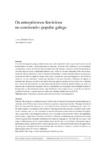Mostrar o rexistro simple do ítem
Os antropónimos femininos na cancioneiro popular galego
| dc.contributor.author | Mariño Taibo, Laura | es_ES |
| dc.date.accessioned | 2014-10-02T12:18:30Z | |
| dc.date.available | 2014-10-02T12:18:30Z | |
| dc.date.issued | 2012 | es_ES |
| dc.identifier.citation | Novas achegas ao estudo da cultura galega II. Enfoques socio-históricos e lingüístico-literarios; 2012: 37-50. ISBN: 978-84-9749-517-2 | es_ES |
| dc.identifier.isbn | 978-84-9749-517-2 | es_ES |
| dc.identifier.uri | http://hdl.handle.net/2183/13254 | |
| dc.description.abstract | [Resumo] O cancioneiro popular galego preséntasenos como unha importante fonte a que recorrer para o estudo da onomástica en xeral, e da antroponimia en particular, do século XIX, centuria en que se recompila un importante corpus. A través do estudo dunhas catro mil cantigas veremos o estado da antroponimia feminina naquela altura, completando ademais esta visión con estudos realizados sobre outros documentos de épocas anteriores, como o Catastro de Ensenada, e mesmo facendo referencias puntuais á evolución do nome co pasar do tempo, todo desde un punto de vista sociolingüístico. Son varios os piares en que nos apoiamos: nomes que aparecen e con que frecuencia, influencia da Igrexa na antroponimia, presenza de nomes do ámbito relixioso, grao de penetración do español etc. Coidamos que o estudo da antroponimia no cancioneiro popular pode resultar de grande interese, en tanto que estamos ante composicións populares e de orixe espontánea que se achegan máis á realidade lingüística da época do que documentos de índole legal. Dando por certo o tópico de que «a escolla dos nomes é cuestión de modas», vexamos pois cales eran esas «modas» arredor dos século XIX. | es_ES |
| dc.description.abstract | [Abstract] Galician folk songs are an important source for the study of onomastics in general and anthroponymy in particular in the 19th century, a time in which an important corpus was compiled. Through the study of about four thousand folk songs we will try to show the status of feminine anthroponymy in that time. We shall complete this analysis with studies of other documents from previous centuries, as the Catastro de Ensenada, and we will even make occasional references to the evolution of names throughout time, always from a sociolinguistic point of view. Our study relies on several pillars: the appearance and frecuency of appearance of names, the Church’s influence on anthroponymy, the presence of names from a religious realm, the grade of penetration of Spanish language, etc. We hold that the study of folk songs in anthroponymy can be of great interest, due to the fact that we are dealing with popular songs of spontaneous origin, which are closer to the linguistic reality of the time than documents of legal nature. By taking into consideration the commonplace that »the choice of names is a matter of fashion», we shall question these 19th century «fashions». | es_ES |
| dc.language.iso | glg | es_ES |
| dc.publisher | Universidade da Coruña | es_ES |
| dc.subject | Folk songs | es_ES |
| dc.subject | Women anthroponymy | es_ES |
| dc.subject | Sociolinguistics | es_ES |
| dc.subject | Cancioneiro popular | es_ES |
| dc.subject | Antroponimia feminina | es_ES |
| dc.subject | Sociolingüística | es_ES |
| dc.title | Os antropónimos femininos na cancioneiro popular galego | es_ES |
| dc.type | info:eu-repo/semantics/conferenceObject | es_ES |
| dc.rights.access | info:eu-repo/semantics/openAccess | es_ES |






